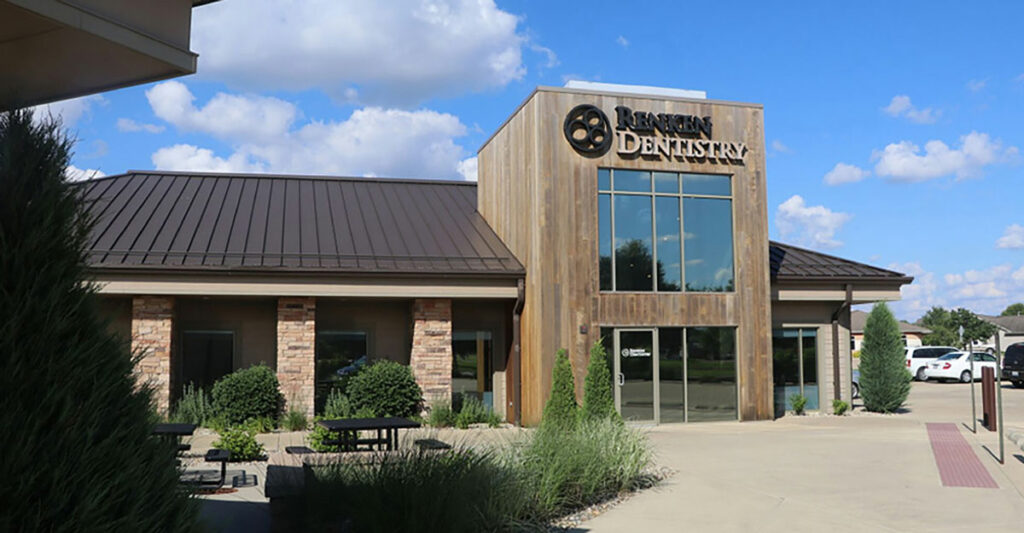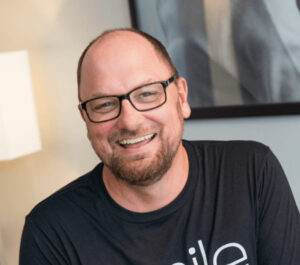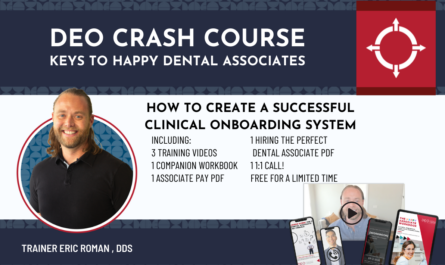Renken Dentistry’s systems helped it grow and scale in two different states.
By Daniel Beaird
All your plans can be in place and then life happens. After opening two dental locations in Illinois, Dr. Josh Renken, CEO and founder of Renken Dentistry, moved his family to Texas seeking better care for his daughter who has a rare genetic abnormality.
“We looked around the country to find a place that could support her path and we found a place like that in Austin, Texas,” he said. “So, we decided to go to Austin and open a dental practice, and we’ve opened one per year for the past five years, on average.”
Right away, Dr. Renken learned what was and wasn’t scalable and replicable running practices in two different states. “You take so many things for granted that you think are replicable when you add another location,” he said. “But being in two states is different. It put a constraint on our business that was hard but healthy.”
As Dr. Renken grew his practices, it was important to him to have something replicable and not personality-driven. “It really was built by design to completely express our values, to pursue our mission, and to be very focused,” he said.
Renken Dentistry developed its Path to Health to help patients create a treatment plan and know what to expect. “I wanted patients to have the same experience no matter what hygienist or what assistant they see,” Dr. Renken said. “We’re all human and there’s going to be some variation, but I wanted to start streamlining things.”
The Path to Health is on every operatory wall at Renken Dentistry locations so even patients can speak the same language. “Our team is on the same page – patients, doctors, hygienists, assistants, everybody,” he said.
Path to Health
When patients walk into a Renken Dentistry office, they see a big sign that states Renken’s mission is leading its teams, patients and practices to greater levels of health.
“We turned our mission into an objective step-by-step path for our team, our patients and our practices,” Dr. Renken said. “Every employee interview filters through that. Performance evaluations and growth check-ins filter through it.”
These paths are on the walls. They are everywhere. “We don’t have office managers or regional managers, but our team’s shared clarity of purpose can replace that human presence,” he said.
“The only way I’m going to help a patient save money over the course of their life is to keep them on the Path to Health,” he added. “So, I can point to that instead of saying let me give you a better discount on advanced disease.”
Renken Dentistry gives patients five steps on its Path to Health and patients can see where they are on the path. They include:
1. Emergency relief.
2. Understand each other fully.
3. Make a plan together.
4. Active disease under control.
5. Stay healthy together.
“It’s so powerful when you’re communicating with a patient that’s scared,” he said. “If we get to health together, the patient doesn’t have to spend so much time with us. It helps the doctors and hygienists have an objective reference.”
It helps Dr. Renken coach the team too when things don’t go right with a patient. Typically, he can identify where things went wrong on the path. “It might be because we didn’t spend enough time on the second stage of understanding each other fully,” he said. “Either we didn’t understand the patient, or they didn’t understand their health disposition and we moved down this path without being clear.”
If there’s a failure in step three when they plan together, then the doctor might have suggested a crown before the patient even knew what was going on. “Do we spend enough time understanding the patient’s health before we start talking about solutions or plans,” Dr. Renken asked. “That’s a nice way to show our team what we do.”
If failure is in the fourth step and the patient doesn’t want to spend money to get an advancing disease under control, things will only get more expensive for them. “It only gets more debilitating with more chances for pain every day if we don’t get them off of the fourth step – getting the disease under control,” he said. “Are we going to get the disease under control or are we going to go all the way back to step one?”

No administrators
For every doctor on the Renken Dentistry team, there are two to three assistants and one to two hygienists. If it’s an office with two doctors, then there are five assistants and three hygienists if the office is single column. And there are no administrators.
“We invest a lot of development in our dental assistants but they’re doing so many things because there’s no administrators,” Dr. Renken said. “Somebody’s in charge of grabbing the mail, but you have to have systems around just the simplest tasks that administrators used to do.”
Renken Dentistry has kiosks at the front for patients to check in through Open Dental.
“There’s all these interactions you have to design for,” he said. “But they’re regular and easy to organize around. We use a ticketing system that flows up to our central management team because you can lose the goodwill of your clinical team if they don’t feel supported and someone’s going to solve their problems.”
Central patient coordinators virtually present to the clinical team at the beginning of each day. They talk about their results from the day before and have a riddle of the day or a contest for the clinical team. Maybe they have some music playing.
“They just get the day started and the clinical team doesn’t have to do any of that,” Dr. Renken said. “They organize the huddle, which was a challenge in the old days of administrators because everyone would argue over it or not have time because patients were calling, or someone was setting up chairs.”
Now, the clinical team walks in ready to be presented with their perfect day and the day’s goal. It’s a good checkpoint to check on any issues that have arisen. It can also be fun and drive culture. “Whether you have two practices or seven or 10, you can push out news to make sure everyone’s getting the team news. You can also push out a little system update or anything like that,” he said. “So, it’s very structured and there’s a lot of value in it that we didn’t have before when each office was doing their own thing.”
Having two to three assistants for every doctor allows Renken Dentistry to handle treatment plans, seating patients, taking X-rays, collecting payments, and more without an administrator on site. “If the doctor is in one room and they’re in another, there’s still an extra assistant around to present treatment and we teach a very structured treatment presentation,” Dr. Renken said. “We monitor a metric called our care progress rate to see how successful they are at that.”
Dr. Renken says most of their offices are around 50-55% of patients taking the next step, and offices can get competitive over that. Renken Dentistry shows their offices which ones have the best progress rate. “We can get some good days when we’re at 60%, 70% or 80%,” he said.
New patient experience
The new patient experience can be complicated between insurance verification and interactions with patient coordinators. Renken Dentistry tackles this through a call center that’s broken into four groups:
1. New patient coordinators.
2. Existing patient coordinators.
3. Operators.
4. Outbound coordinators.
“Our new patient coordinators are our all-stars on the phones,” Dr. Renken said. “They consistently have an 85-90% conversion rate.”
It goes through a ticketing system that routes to the insurance verification team. There’s some automation to verify insurance but there’s also a human backstop to take the ones that can’t be automated. Dr. Renken says the goal is to have as many insurance verifications done as possible 48 hours before a new patient is scheduled. “That’s one of our biggest workloads because if you’re in a de novo space and you have a lot of new patients, it can get a little hairy,” he said. “So that definitely needs to be ironed out.”
New patients enter a Renken Dentistry office and enter their name and birthdate in a front office kiosk and a light goes on in the back office on all computers that a new patient has arrived. “Our chairs and our welcome space are intimate,” Dr. Renken said. “Our team is walking around and seeing people come in. They rarely wait for more than a few minutes to get into a chair with nine chairs and two doctors. That typically makes people pretty happy.”
New patients have 90 minutes with a hygienist or start with an assistant in the restorative column or chair and complete the second half of the appointment with a hygienist. They also go through an iTero wellness scan. “We have a laminated form for exactly how a new patient encounter goes,” Dr. Renken said. “It’s in every room and office. It’s always the same. We’re just following the Path to Health and there’s an encounter form for each step.”
Insurance questions and ticketing systems
Renken Dentistry uses a QR code for complicated insurance questions because its clinical team was frustrated trying to answer those questions and translate them. So, it has a QR code that sends these questions directly to its insurance team.
“We mark it ‘In Chair’ so it’s an urgent ticket that the team is going to get on right away,” he said. “Or in other cases, a patient might have a complicated billing or insurance question and we give the patient a QR code that they can upload on their phone and follow the ticket through themselves.”
Automation posts the dialogue into Open Dental, including the ticket resolution or lack thereof, so the office can follow the progress. All of the information is attached to a patient’s record, and it makes it easier to handle. “There are so many patients that you want to have a record of the dialogue as opposed to it being a free-for-all on the phone,” Dr. Renken said.
Renken Dentistry has been through multiple ticketing systems, but Dr. Renken thinks the most important thing is having an omnichannel system for the central team. “We have the practices, the clinical team members, and the patients,” he said. “There are so many routes of input now. We use Freshdesk as our provider and it’s built on Twilio. It’s omnichannel so chats can come in through Facebook, Google, phones, texts, and all those QR codes that come in as tickets.”
That allows Renken Dentistry to get to a common theme around support, velocity, and assurance at its central management level.
Renken’s path for its clinical teams
Renken Dentistry has another five-step path for its clinical team including:
1. Living the way.
2. Delivering the way.
3. Growing the way.
4. Leading the way.
5. Teaching the way.
“You go from living the mission to delivering the way to growing as a team member,” Dr. Renken said. “And some team members want to grow professionally and assume more leadership or responsibility around the office. We have a leadership program that they go through and achieve certification.”
Lastly, Renken Dentistry has a teaching-the-way program that team members can participate in by mentoring new team members through steps one and two – living the mission and delivering the way – and they are compensated for it.
For its doctors, Renken wants diversity of thought on how to get advancing diseases under control.
“That’s the benefit of being in a group,” Dr. Renken said. “But on the flip side, our structure is like a checklist manifesto – before, during, and after – for each of those steps on the Path to Health. It’s like a training guide.”






